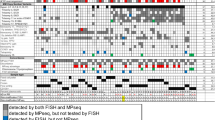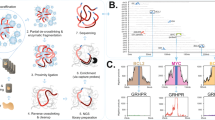Abstract
Chromosomal aberrations with breakpoints in T-cell receptor (TCR) gene loci are recurrent in several T-cell malignancies. Although the importance of interphase cytogenetics has been extensively shown in B-cell lymphomas, hardly any molecular cytogenetic tools are available for recurrent changes in T-cell disorders. Thus, we have established fluorescence in situ hybridization (FISH)-based break-apart assays for the TCRA/D (14q11), TCRB (7q34) and TCRG (7p14) genes and the TCL cluster (14q32). The assays were validated in normal controls as well as in 43 T-cell malignancies with cytogenetically proven 14q11, 7q34–35 or 7p13–21 aberrations. Breakpoints in TCRA/D, TCRB and TCRG could be diagnosed by these assays in 32/33 T-cell neoplasms with chromosome 14q11, 3/6 with 7q34–35 and 1/7 with 7p13–21 alterations, respectively. Application of the new FISH assays to a series of 24 angioimmunoblastic and 12 cutaneous T-cell lymphomas confirmed the cytogenetic evidence of lack of breakpoints in the TCRA/D or TCRB locus. Simultaneous detection of TCRA/D or TCRB breaks was achieved in a multicolor approach, which was further combined with detection of the T-cell-specific CD3 antigen in a multicolor FICTION (Fluorescence Immunophenotyping and Interphase Cytogenetics as a Tool for the Investigation of Neoplasm) assay. These new FISH and FICTION assays provide sensitive, rapid and accurate tools for the diagnosis and biological characterization of T-cell malignancies.
This is a preview of subscription content, access via your institution
Access options
Subscribe to this journal
Receive 12 print issues and online access
$259.00 per year
only $21.58 per issue
Buy this article
- Purchase on Springer Link
- Instant access to full article PDF
Prices may be subject to local taxes which are calculated during checkout





Similar content being viewed by others
References
Brunning RD, Borowitz M, Matutes E, Head D, Flandrin G, Swerdlow SH et al. Precursor T lymphoblastic leukaemia/lymphoblastic lymphoma. In: Jaffe ES, Harris NL, Stein H, Vardiman JW (eds). World Health Organization Classification of Tumors. Pathology and Genetics of Tumors of Haematopoietic and Lymphoid Tissues. Lyon: IARC Press, 2001, pp 115–117.
Jaffe ES, Ralfkiaer E . Mature T-cell and NK-cell neoplasms: introduction. In: Jaffe ES, Harris NL, Stein H, Vardiman JW (eds). World Health Organization Classification of Tumors. Pathology and Genetics of Tumors of Haematopoietic and Lymphoid Tissues. Lyon: IARC Press, 2001, pp 191–194.
Willis TG, Dyer MJ . The role of immunoglobulin translocations in the pathogenesis of B-cell malignancies. Blood 2000; 96: 808–822.
Siebert R, Rosenwald A, Staudt LM, Morris SW . Molecular features of B-cell lymphoma. Curr Opin Oncol 2001; 13: 316–324.
Matutes E, Brito-Babapulle V, Swansbury J, Ellis J, Morilla R, Dearden C et al. Clinical and laboratory features of 78 cases of T-prolymphocytic leukemia. Blood 1991; 78: 3269–3274.
Schneider NR, Carroll AJ, Shuster JJ, Pullen DJ, Link MP, Borowitz MJ et al. New recurring cytogenetic abnormalities and association of blast cell karyotypes with prognosis in childhood T-cell acute lymphoblastic leukemia: a pediatric oncology group report of 343 cases. Blood 2000; 96: 2543–2549.
Ferrando AA, Look AT . Clinical implications of recurring chromosomal and associated molecular abnormalities in acute lymphoblastic leukemia. Semin Hematol 2000; 37: 381–395.
Chaganti RS, Nanjangud G, Schmidt H, Teruya-Feldstein J . Recurring chromosomal abnormalities in non-Hodgkin's lymphoma: biologic and clinical significance. Semin Hematol 2000; 37: 396–411.
Korsmeyer SJ . Chromosomal translocations in lymphoid malignancies reveal novel proto-oncogenes. Annu Rev Immunol 1992; 10: 785–807.
Rabbitts TH . Chromosomal translocations in human cancer. Nature 1994; 372: 143–149.
Hallas C, Pekarsky Y, Itoyama T, Varnum J, Bichi R, Rothstein JL et al. Genomic analysis of human and mouse TCL1 loci reveals a complex of tightly clustered genes. Proc Natl Acad Sci USA 1999; 96: 14418–14423.
Saitou M, Sugimoto J, Hatakeyama T, Russo G, Isobe M . Identification of the TCL6 genes within the breakpoint cluster region on chromosome 14q32 in T-cell leukemia. Oncogene 2000; 19: 2796–2802.
Wang J, Jani-Sait SN, Escalon EA, Carroll AJ, de Jong PJ, Kirsch IR et al. The t(14;21)(q11.2;q22) chromosomal translocation associated with T-cell acute lymphoblastic leukemia activates the BHLHB1 gene. Proc Natl Acad Sci USA 2000; 97: 3497–3502.
Fisch P, Forster A, Sherrington PD, Dyer MJ, Rabbitts TH . The chromosomal translocation t(X;14)(q28;q11) in T-cell pro-lymphocytic leukaemia breaks within one gene and activates another. Oncogene 1993; 8: 3271–3276.
Virgilio L, Narducci MG, Isobe M, Billips LG, Cooper MD, Croce CM et al. Identification of the TCL1 gene involved in T-cell malignancies. Proc Natl Acad Sci USA 1994; 91: 12530–12534.
Schlegelberger B, Himmler A, Gödde E, Grote W, Feller AC, Lennert K . Cytogenetic findings in peripheral T-cell lymphomas as a basis for distinguishing low-grade and high-grade lymphomas. Blood 1994; 83: 505–511.
Schlegelberger B, Zhang Y, Weber-Matthiesen K, Grote W . Detection of aberrant clones in nearly all cases of angioimmunoblastic lymphadenopathy with dysproteinemia-type T-cell lymphoma by combined interphase and metaphase cytogenetics. Blood 1994; 84: 2640–2648.
Thangavelu M, Finn WG, Yelavarthi KK, Roenigk Jr HH, Samuelson E, Peterson L et al. Recurring structural chromosome abnormalities in peripheral blood lymphocytes of patients with mycosis fungoides/Sezary syndrome. Blood 1997; 89: 3371–3377.
Lepretre S, Buchonnet G, Stamatoullas A, Lenain P, Duval C, d’Anjou J et al. Chromosomal abnormalities in peripheral T-cell lymphoma. Cancer Genet Cytogenet 2000; 117: 71–79.
Wlodarska I, La Starza R, Baens M, Dierlamm J, Uyttebroeck A, Selleslag D et al. Fluorescence in situ hybridization characterization of new translocations involving TEL (ETV6) in a wide spectrum of hematologic malignancies. Blood 1998; 91: 1399–1406.
Martin-Subero JI, Harder L, Gesk S, Schlegelberger B, Grote W, Martinez-Climent JA et al. Interphase FISH assays for the detection of translocations with breakpoints in immunoglobulin light chain loci. Int J Cancer 2002; 98: 470–474.
van der Burg M, Smit B, Brinkhof B, Barendregt BH, Verschuren MC, Dib M et al. A single split-signal FISH probe set allows detection of TAL1 translocations as well as SIL-TAL1 fusion genes in a single test. Leukemia 2002; 16: 755–761.
Siebert R, Weber-Matthiesen K . Fluorescence in situ hybridization as a diagnostic tool in malignant lymphomas. Histochem Cell Biol 1997; 108: 391–402.
Kearney L . The impact of the new FISH technologies on the cytogenetics of haematological malignancies. Br J Haematol 1999; 104: 648–658.
Gozzetti A, Le Beau MM . Fluorescence in situ hybridization: uses and limitations. Semin Hematol 2000; 37: 320–333.
Weber-Matthiesen K, Winkemann M, Müller-Hermelink A, Schlegelberger B, Grote W . Simultaneous fluorescence immunophenotyping and interphase cytogenetics: a contribution to the characterization of tumor cells. J Histochem Cytochem 1992; 40: 171–175.
Martin-Subero JI, Chudoba I, Harder L, Gesk S, Grote W, Novo FJ et al. Multicolor-FICTION: expanding the possibilities of combined morphologic, immunophenotypic, and genetic single cell analyses. Am J Pathol 2002; 161: 413–420.
Reinhardt P, Maschmeyer G, Schulze G, Fleischer C, Ellerbrok H, Schlegelberger B et al. First non-imported HTLV-1 positive adult T cell leukemia/lymphoma (ATLL) in Germany. Leukemia 1999; 13: 1296–1297.
Kahl C, Gesk S, Harder L, Harbott J, French L, Deloukas P et al. Detection of translocations involving the HOX11/TCL3-locus in 10q24 by interphase fluorescence in situ hybridization. Cancer Genet Cytogenet 2001; 129: 80–84.
Bernard OA, Busson-LeConiat M, Ballerini P, Mauchauffe M, Della Valle V, Monni R et al. A new recurrent and specific cryptic translocation, t(5;14)(q35;q32), is associated with expression of the Hox11L2 gene in T acute lymphoblastic leukemia. Leukemia 2001; 15: 1495–1504.
Martin-Subero JI, Gesk S, Harder L, Sonoki T, Tucker PW, Schlegelberger B et al. Recurrent involvement of the REL and BCL11A loci in classical Hodgkin lymphoma. Blood 2002; 99: 1474–1477.
Vockerodt M, Belge G, Kube D, Irsch J, Siebert R, Tesch H et al. An unbalanced translocation involving chromosome 14 is the probable cause for loss of potentially functional rearranged immunoglobulin heavy chain genes in the EBV-positive Hodgkińs lymphoma-derived cell line L591. Br J Haematol 2002; 119: 690–696.
Bentz M, Cabot G, Moos M, Speicher MR, Ganser A, Lichter P et al. Detection of chimeric BCR–ABL genes on bone marrow samples and blood smears in chronic myeloid and acute lymphoblastic leukemia by in situ hybridization. Blood 1994; 83: 1922–1928.
Avet-Loiseau H, Brigaudeau C, Morineau N, Talmant P, Lai JL, Daviet A et al. High incidence of cryptic translocations involving the Ig heavy chain gene in multiple myeloma, as shown by fluorescence in situ hybridization. Genes Chromosomes Cancer 1999; 24: 9–15.
Harris NL, Jaffe ES, Vardiman JW, Stein H, Diebold J, Müller-Hermelink HK et al. WHO classification of haematopoietic and lymphoid tissues: introduction. In: Jaffe ES, Harris NL, Stein H, Vardiman JW (Eds). World Health Organization Classification of Tumours. Pathology and Genetics of Tumours of Haemopoietic and Lymphoid Tissues. Lyon: IARC press, 2001, pp 12–13.
Drexler HG, Gignac SM, von Wasielewski R, Werner M, Dirks WG . Pathobiology of NPM-ALK and variant fusion genes in anaplastic large cell lymphoma and other lymphomas. Leukemia 2000; 14: 1533–1559.
Duyster J, Bai RY, Morris SW . Translocations involving anaplastic lymphoma kinase (ALK). Oncogene 2001; 20: 5623–5637.
Rabbitts TH . LMO T-cell translocation oncogenes typify genes activated by chromosomal translocations that alter transcription and developmental processes. Genes Dev 1998; 12: 2651–2657.
Rack KA, Cornelis F, Radford-Weiss I, Bernheim A, Harrison CJ, Hermine O et al. A chromosome 14q11/TCR alpha/delta specific yeast artificial chromosome improves the detection rate and characterization of chromosome abnormalities in T-lymphoproliferative disorders. Blood 1997; 90: 1233–1240.
Rowen L, Koop BF, Hood L . The complete 685-kilobase DNA sequence of the human beta T cell receptor locus. Science 1996; 272: 1755–1762.
Boysen C, Simon MI, Hood L . Analysis of the 1.1-Mb human alpha/delta T-cell receptor locus with bacterial artificial chromosome clones. Genome Res 1997; 7: 330–338.
Rayet B, Gelinas C . Aberrant Rel/NfκB genes and activity in human cancer. Oncogene 1999; 18: 6938–6947.
Joos S, Menz CK, Wrobel G, Siebert R, Gesk S, Ohl S et al. Classical Hodgkin lymphoma is characterized by recurrent copy number gains of the short arm of chromosome 2. Blood 2002; 99: 1381–1387.
Kamada N, Sakurai M, Miyamoto K, Sanada I, Sadamori N, Fukuhara S et al. Chromosome abnormalities in adult T-cell leukemia/lymphoma: a karyotype review committee report. Cancer Res 1992; 52: 1481–1493.
Tsukasaki K, Krebs J, Nagai K, Tomonaga M, Koeffler HP, Bartram CR et al. Comparative genomic hybridization analysis in adult T-cell leukemia/lymphoma: correlation with clinical course. Blood 2001; 97: 3875–3881.
Itoyama T, Chaganti RS, Yamada Y, Tsukasaki K, Atogami S, Nakamura H et al. Cytogenetic analysis and clinical significance in adult T-cell leukemia/lymphoma: a study of 50 cases from the human T-cell leukemia virus type-1 endemic area, Nagasaki. Blood 2001; 97: 3612–3620.
Itoyama T, Sadamori N, Yamada Y, Tomogana M, Isobe M . Molecular cytogenetic analysis of chromosome 14 at band q32 region in adult T-cell leukemia: a study of 50 cases and its clinical significance. Blood 1999; 94: 497a.
Avram D, Fields A, Senawong T, Topark-Ngarm A, Leid M . COUP-TF-interacting protein 1 (CTIP1) is a sequence-specific DNA binding protein. Biochem J (in press).
Satterwhite E, Sonoki T, Willis TG, Harder L, Nowak R, Arriola EL et al. The BCL11 gene family: involvement of BCL11A in lymphoid malignancies. Blood 2001; 98: 3413–3420.
Acknowledgements
The excellent technical assistance of Reina Zühlke-Jenisch, Claudia Becher and Dorit Schuster is gratefully acknowledged. Dr Ilse Chudoba from MetaSystems assisted us with the multicolor imaging.
Author information
Authors and Affiliations
Additional information
This study has been supported by the Hensel-Stiftung (Kiel), the Interdisziplinäre Zentrum für klinische Krebsforschung (IZKF, Kiel) and the Deutsche Krebshilfe.
Rights and permissions
About this article
Cite this article
Gesk, S., Martín-Subero, J., Harder, L. et al. Molecular cytogenetic detection of chromosomal breakpoints in T-cell receptor gene loci. Leukemia 17, 738–745 (2003). https://doi.org/10.1038/sj.leu.2402884
Published:
Issue Date:
DOI: https://doi.org/10.1038/sj.leu.2402884
Keywords
This article is cited by
-
Peripheral T-cell lymphoma with t(6;14)(p25;q11.2) translocation presenting with massive splenomegaly
Virchows Archiv (2014)
-
A second NOTCH1 chromosome rearrangement: t(9;14)(q34.3;q11.2) in T-cell neoplasia
Leukemia (2009)
-
Inhibition of BCL11B expression leads to apoptosis of malignant but not normal mature T cells
Oncogene (2007)
-
Short telomeres and high telomerase activity in T-cell prolymphocytic leukemia
Leukemia (2007)
-
Disruption of the BCL11B gene through inv(14)(q11.2q32.31) results in the expression of BCL11B-TRDC fusion transcripts and is associated with the absence of wild-type BCL11B transcripts in T-ALL
Leukemia (2005)



